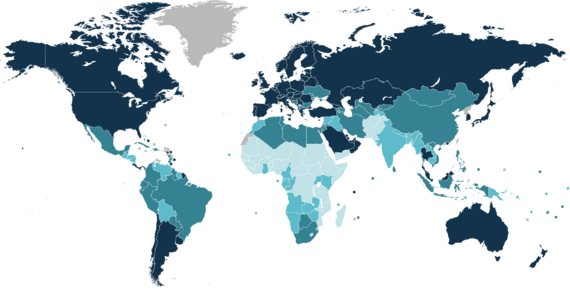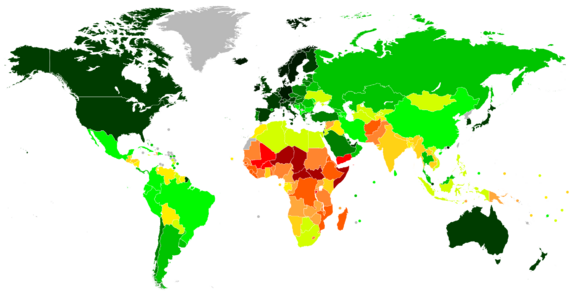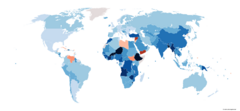List of countries by Human Development Index facts for kids

- Very high (0.800 or more)
- High (0.700–0.799)
- Medium (0.550–0.699)
- Low (0.549 or less)
- No data

- 0.950 or more
- 0.900–0.950
- 0.850–0.899
- 0.800–0.849
- 0.750–0.799
- 0.700–0.749
- 0.650–0.699
- 0.600–0.649
- 0.550–0.599
- 0.500–0.549
- 0.450–0.499
- 0.400–0.449
- 0.399 or less
- No data
The Human Development Index (HDI) is a special number that helps us understand how well people are living in different countries. It's put together every year by the United Nations Development Programme (UNDP). The HDI looks at three main things: how healthy people are, how much education they get, and their income or living conditions.
This index helps us compare how countries are doing in terms of human development over time. It's the most popular way to measure this. Some people think the HDI is a bit too simple. They say it doesn't include everything, like how fair things are for everyone or how countries affect the environment. Because of this, the UNDP has made other versions, like the Inequality-adjusted HDI (IHDI) and the Planetary Pressures–adjusted HDI (PHDI). The PHDI lowers a country's score if it has a big impact on the environment.
Also, to show differences within countries, a special subnational HDI (SHDI) was started in 2018. This gives information for over 1,600 regions inside countries.
What the HDI Measures
The HDI was first created in 1990. Its main goal was to give a better picture of human development than just looking at how much money a country makes (like gross domestic product).
The HDI focuses on three important parts of human development:
- A long and healthy life.
- Knowledge and education.
- A good standard of living.
To figure out how countries are doing in each part, they use different numbers. For example, for a long and healthy life, they look at how long people are expected to live. For knowledge, they look at how many years children are expected to go to school and how many years adults actually went to school. For living standards, they look at the average gross national income (GNI) per person.
Each of these parts gets a score between 0 and 1. Then, these three scores are combined to get the final Human Development Index.
Here's how the scores are grouped:
- A score above 0.800 means "very high" human development.
- Between 0.700 and 0.799 is "high" human development.
- From 0.550 to 0.699 is "medium" human development.
- Below 0.550 is "low" human development.
Most of the information used to calculate the HDI comes from big international groups like the United Nations Educational, Scientific and Cultural Organization (UNESCO) and the World Bank. Because the way HDI is calculated can change a little over time, you can't always compare the scores from different years directly. Each new report usually updates the scores for past years too.
| Parts | What is measured | Score name |
|---|---|---|
| Long and healthy life | Life expectancy at birth | Life expectancy index |
| Knowledge | Expected years of schooling Mean years of schooling |
Education index |
| A decent standard of living | GNI per person (PPP $) | GNI index |
Countries by HDI Score
The Human Development Report includes information for 193 member states of the United Nations, plus Hong Kong SAR and the State of Palestine. However, the HDI is not fully calculated for DPR Korea (North Korea) and Monaco. A few other small countries like the Cook Islands, the Holy See (Vatican City), and Niue are not included in the report at all. In total, the HDI is available for 192 countries and one territory.
The countries are grouped into four levels based on their 2022 HDI score:
- Countries ranked 1 to 69 have "very high" HDI.
- Countries ranked 70 to 115 have "high" HDI.
- Countries ranked 116 to 159 have "medium" HDI.
- Countries ranked 160 to 193 have "low" HDI.
The data below is for the year 2022.
| Rank | Δ | Country or territory | HDI value | % annual growth (2010–2022) |
|---|---|---|---|---|
| 1 | 0.967 | |||
| 2 | 0.966 | |||
| 3 | 0.959 | |||
| 4 | 0.956 | |||
| 5 | 0.952 | |||
| 7 | 0.950 | |||
| 9 | 0.949 | |||
| 10 | 0.946 | |||
| 12 | 0.942 | |||
| 15 | 0.940 | |||
| 16 | 0.939 | |||
| 17 | 0.937 | |||
| 18 | 0.935 | |||
| 19 | 0.929 | |||
| 20 | 0.927 | |||
| 22 | 0.926 | |||
| 24 | 0.920 | |||
| 25 | 0.915 | |||
| 27 | 0.911 | |||
| 28 | 0.910 | |||
| 29 | 0.907 | |||
| 30 | 0.906 | |||
| 31 | 0.899 | |||
| 32 | 0.895 | |||
| 33 | 0.893 | |||
| 34 | 0.888 | |||
| 35 | 0.884 | |||
| 36 | 0.881 | |||
| 37 | 0.879 | |||
| 39 | 0.878 | |||
| 40 | 0.875 | |||
| 42 | 0.874 | |||
| 43 | 0.867 | |||
| 44 | 0.860 | |||
| 45 | 0.855 | |||
| 47 | 0.851 | |||
| 48 | 0.849 | |||
| 49 | 0.847 | |||
| 50 | 0.844 | |||
| 51 | 0.838 | |||
| 52 | 0.830 | |||
| 53 | 0.827 | |||
| 54 | 0.826 | |||
| 55 | 0.836 | |||
| 56 | 0.821 | |||
| 57 | 0.820 | |||
| 59 | 0.819 | |||
| 60 | 0.814 | |||
| 62 | 0.809 | |||
| 63 | 0.807 | |||
| 64 | 0.806 | |||
| 65 | 0.805 | |||
| 66 | 0.803 | |||
| 67 | 0.802 | |||
| 69 | 0.801 | |||
| 70 | 0.799 | |||
| 71 | 0.797 | |||
| 72 | 0.796 | |||
| 73 | 0.793 | |||
| 74 | 0.789 | |||
| 75 | 0.788 | |||
| 76 | 0.786 | |||
| 77 | 0.781 | |||
| 78 | 0.780 | |||
| 80 | 0.779 | |||
| 81 | 0.772 | |||
| 82 | 0.766 | |||
| 83 | 0.765 | |||
| 85 | 0.764 | |||
| 86 | 0.763 | |||
| 87 | 0.762 | |||
| 89 | 0.760 | |||
| 91 | 0.758 | |||
| 92 | 0.746 | |||
| 93 | 0.745 | |||
| 94 | 0.744 | |||
| 95 | 0.742 | |||
| 96 | 0.741 | |||
| 97 | 0.740 | |||
| 98 | 0.739 | |||
| 99 | 0.736 | |||
| 100 | 0.734 | |||
| 101 | 0.732 | |||
| 102 | 0.731 | NA | ||
| 104 | 0.729 | |||
| 105 | 0.728 | |||
| 106 | 0.727 | |||
| 107 | 0.726 | |||
| 108 | 0.725 | |||
| 109 | 0.723 | |||
| 110 | 0.717 | |||
| 111 | 0.716 | |||
| 112 | 0.713 | |||
| 113 | 0.710 | |||
| 114 | 0.708 | |||
| 115 | 0.706 | |||
| 116 | 0.702 | |||
| 117 | 0.701 | |||
| 118 | 0.700 | |||
| 119 | 0.699 | |||
| 120 | 0.698 | |||
| 122 | 0.696 | |||
| 123 | 0.693 | |||
| 124 | 0.690 | |||
| 125 | 0.681 | |||
| 126 | 0.679 | |||
| 127 | 0.674 | |||
| 128 | 0.673 | |||
| 129 | 0.670 | |||
| 130 | 0.669 | |||
| 131 | 0.661 | |||
| 132 | 0.653 | |||
| 133 | 0.650 | |||
| 134 | 0.644 | |||
| 135 | 0.634 | |||
| 136 | 0.629 | |||
| 137 | 0.628 | |||
| 138 | 0.624 | |||
| 139 | 0.620 | |||
| 140 | 0.614 | |||
| 141 | 0.613 | |||
| 142 | 0.610 | |||
| 144 | 0.608 | |||
| 145 | 0.602 | |||
| 146 | 0.601 | |||
| 148 | 0.600 | |||
| 149 | 0.593 | |||
| 150 | 0.591 | |||
| 151 | 0.587 | |||
| 152 | 0.586 | |||
| 153 | 0.569 | |||
| 154 | 0.568 | |||
| 155 | 0.566 | |||
| 156 | 0.562 | |||
| 157 | 0.557 | |||
| 158 | 0.552 | |||
| 159 | 0.550 | |||
| 161 | 0.548 | |||
| 163 | 0.547 | |||
| 164 | 0.540 | |||
| 166 | 0.534 | |||
| 167 | 0.532 | |||
| 168 | 0.521 | |||
| 169 | 0.517 | |||
| 170 | 0.516 | |||
| 171 | 0.515 | |||
| 172 | 0.508 | |||
| 173 | 0.504 | |||
| 174 | 0.495 | |||
| 175 | 0.493 | |||
| 176 | 0.492 | |||
| 177 | 0.487 | |||
| 179 | 0.483 | |||
| 180 | 0.481 | |||
| 181 | 0.471 | |||
| 182 | 0.462 | |||
| 183 | 0.461 | |||
| 184 | 0.458 | |||
| 185 | 0.438 | |||
| 186 | 0.424 | |||
| 187 | 0.420 | |||
| 188 | 0.410 | |||
| 189 | 0.394 | |||
| 191 | 0.387 | |||
| 192 | 0.381 | |||
| 193 | NA | 0.380 | NA |
HDI for Groups of Countries
The Human Development Report also gives HDI scores for different groups of countries. These groups can be based on their location (like regions) or if they belong to certain international organizations.
The HDI for these groups is calculated in the same way as for single countries. They just use the average information for all the countries in that group.
| Region or group | 1990 | 2000 | 2010 | 2020 | 2021 | 2022 |
|---|---|---|---|---|---|---|
| OECD | 0.795 | 0.840 | 0.875 | 0.897 | 0.899 | 0.906 |
| Very high human development | 0.784 | 0.826 | 0.868 | 0.895 | 0.896 | 0.902 |
| Europe and Central Asia | 0.664 | 0.681 | 0.746 | 0.793 | 0.796 | 0.802 |
| East Asia and the Pacific | 0.507 | 0.592 | 0.684 | 0.748 | 0.749 | 0.766 |
| High human development | 0.557 | 0.625 | 0.700 | 0.753 | 0.754 | 0.764 |
| Latin America and the Caribbean | 0.633 | 0.689 | 0.733 | 0.755 | 0.754 | 0.763 |
| World | 0.601 | 0.645 | 0.697 | 0.735 | 0.732 | 0.739 |
| Small Island Developing States | 0.601 | 0.649 | 0.693 | 0.732 | 0.730 | 0.730 |
| Arab states | 0.555 | 0.618 | 0.676 | 0.708 | 0.708 | 0.704 |
| Developing countries | 0.513 | 0.569 | 0.638 | 0.687 | 0.685 | 0.694 |
| South Asia | 0.442 | 0.500 | 0.576 | 0.638 | 0.632 | 0.641 |
| Medium human development | 0.453 | 0.506 | 0.582 | 0.642 | 0.636 | 0.640 |
| Sub-Saharan Africa | 0.407 | 0.430 | 0.503 | 0.549 | 0.547 | 0.549 |
| Least developed countries | 0.357 | 0.408 | 0.487 | 0.542 | 0.540 | 0.542 |
| Low human development | 0.356 | 0.399 | 0.477 | 0.519 | 0.518 | 0.517 |
See also
 In Spanish: Anexo:Países por índice de desarrollo humano para niños
In Spanish: Anexo:Países por índice de desarrollo humano para niños
- List of countries by Human Development Index by region
- Africa
- Asia and Oceania
- Europe
- Latin America
- List of countries by inequality-adjusted Human Development Index
- List of countries by planetary pressures–adjusted Human Development Index


